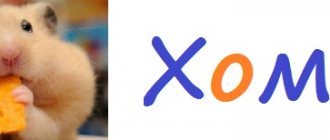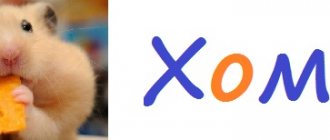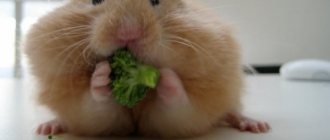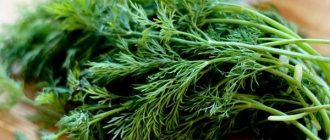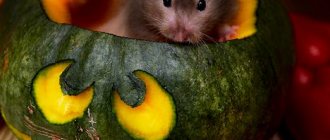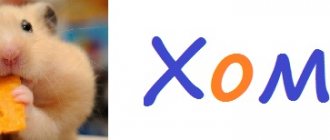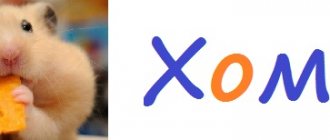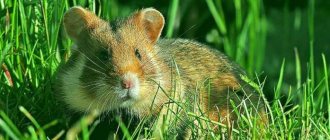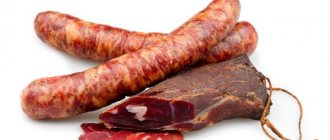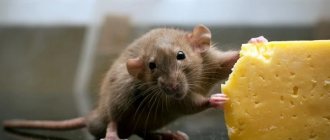The diet of hamsters in nature is not limited to cereals, fruits, and vegetables.
For proper nutrition, they also need protein foods. Let's consider whether hamsters can eat cheese as a product containing a lot of protein. Under natural conditions, rodents usually eat insects (grasshoppers, beetles, butterflies, etc.), as well as worms and larvae. To make up for the lack of protein food, it is recommended for pets to buy specialized food - bloodworms, mealworms, gammarus.
Some pet hamsters are reluctant to eat such complementary foods, and the owners try to supplement the pet's diet with products from their table. To understand whether you can give your hamster cheese, let’s look at the composition of the product in detail.
To give or not?
Can hamsters eat cheese?
To answer this question, you need to determine the fat content of the dairy treat. Like all animals, they need foods that contain a lot of protein from time to time. Rodents are allowed only low-fat cheeses. If this is the type of product you have, you can give your baby a piece that should not exceed the size of a sunflower seed. Such a small portion will benefit your pet.
Often, when choosing cheese for themselves, people give preference to varieties with various flavoring additives, spices and a high salt content. Such a composition will not only be harmful, but even dangerous for the animal. Therefore, you need to buy treats for your hamster separately.
This rule applies to all other products that make up the pet’s diet. By themselves, rodents are not able to distinguish healthy food from harmful food.
Should you give cheese to Djungarian hamsters?
This type of hamster is extremely susceptible to harmful environmental influences. For this reason, it is better not to give dairy treats to dzhungarikas. In addition, the animals have poor health; their small bodies react to any low-quality food.
Cheese and Syrian hamsters
No less popular among hamster breeders is the Syrian breed. You shouldn't treat this pet with cheese either. The salt and fats contained in the product can harm the fragile body of the animal. Only hard, unsalted, low-fat varieties are allowed in small doses. It is better to choose boiled chicken meat as a source of protein.
Should I give it to dzhungarikas and Syrian hamsters?
The answer to the question whether high-fat cheese can be eaten for dzhungarikas is definitely negative. This breed is not very healthy; their body is extremely sensitive to low-quality food, so it’s not worth the risk. Cheese can harm Djungarian hamsters.
Another popular breed of hamster is the Syrian. Giving Syrian hamsters cheese is also not recommended. Salt and fats in the product will harm the health of the baby. Therefore, either choose hard varieties with low fat content and give them rarely and in small portions, or simply treat him to low-fat boiled chicken.
Can hamsters eat grapes?
Hamsters can eat grapes, and they love this healthy fruit. Grapes are berries, but not citrus fruits, so they are completely safe for hamsters. However, if you are keeping diabetic dwarf hamsters, then this product is not suitable for regular feeding.
To make sure grapes are safe for hamsters, you can crush them and see if they have seeds, or, as a last resort, remove them yourself. Grape seeds can pose a choking hazard to hamsters and should always be removed first. And as previously mentioned, dwarf hamster species should not be fed large amounts of sugary foods, and grapes contain a lot of sugar.
What grapes do hamsters prefer? There is no evidence that hamsters prefer green or red grapes, so it comes down to personal preference. You can feed your hamster grapes every few days, and they certainly shouldn't be the main staple of his diet. Eating too many fruits and vegetables, which contain fiber, can cause stomach upset and diarrhea.
Also be careful - hamsters love to hoard and store food. So use fresh food sparingly and check every few days that your hamster has eaten all of his food.
What to do if your hamster has too much cheese
Mistakes happen and you may find that your hamster has eaten more than he should have. One or two binges of cheese are unlikely to harm your hamster, but it is always important to watch for signs of illness such as lethargy, vomiting, diarrhea and loss of appetite. Be sure to contact your exotic veterinarian for advice if you are concerned about your hamster's health.
Hamsters tend to save food for later so that the extra cheese can end up on their cheeks or somewhere in their habitat. Check your hamster's habitat and bedding for hidden cheese stashes and get rid of them. If you're on the fence about feeding your hamster cheese, it's probably best to avoid it entirely and opt for a healthier type of treat.
Milk
Milk is the first food of every mammal's baby. It contains all the necessary components for the child to grow and develop properly. Hamsters also drink their mother's milk from birth until they switch to feeding on their own and there is no need for mother's milk. Under natural conditions, a rodent consumes milk only from its mother, while adults do not consume it and remarkably replenish the need for fluid in the body with ordinary water.
Can hamsters have milk? Since this is an unnatural product for an adult animal, it is not worth offering it.
You can give milk to hamsters in several cases:
- The female who gave birth died, and her newborn babies are not able to feed on their own;
- A pregnant or lactating female is weakened and needs additional feeding;
- The hamster is weakened due to a serious illness and can only eat liquid food.
What kind of milk can be given to hamsters?
If you decide to offer your pet this product, then pay attention to the following points:
- Milk should be low-fat, it is best to use a product with a fat content of no more than 1.5% fat;
- Choose cow's milk over goat's milk, as goat's milk is much fattier;
- Be sure to boil the milk and cool before feeding;
- Use dissolved milk powder, it is easier for rodents to digest;
- Before feeding milk for the first time, be sure to consult your veterinarian.
Benefit or harm?
The owner of a hamster should remember that this is not a cat, and it is not at all necessary for him to drink milk. Of course, you want to please your pet and pamper it. Moreover, milk is the healthiest product! Not for a rodent.
It contains a lot of fat, which will only harm the hamster and not benefit it. Milk and dairy products cause constipation in these animals. A tiny body is not able to digest such food. If you give full-fat milk or cream every day, the hamster will not delight you with its presence for long. He will simply die.
Which varieties are prohibited?
Can hamsters eat cheese with a high content of fat, salt and seasonings? According to experts, such products are contraindicated for pets due to the development of diseases of the cardiovascular, renal and digestive systems. All this negatively affects the general condition of the domestic rodent and can provoke its death.
Processed cheeses
When asked whether a hamster can have this type of cheese, experienced livestock breeders answer that it is not possible. Because it contains fatty foods - cream, butter and milk. It is made on the basis of hard cheeses. Therefore, the fat content of the finished product is very high.
Moreover, some unscrupulous manufacturers add cheap vegetable substitutes, such as palm oil, instead of natural vegetable oils. And to improve the taste of such products, various flavors, seasonings and other additives are added.
Sausage cheese is a type of processed product. Its excellent taste and aroma is also achieved through various additives that are harmful to the health of the rodent.
Sweet processed cheese contains increased amounts of sugar, cocoa, and various sweeteners. They can cause the development of diabetes in a hamster, as well as many other diseases of the cardiovascular system.
Therefore, when asked whether it is possible to feed hamsters processed cheese, experts give an unequivocal answer - No!
Product with mold
This delicacy appeared in our country relatively recently, but is already very popular and in demand. Is it possible to give a hamster blue cheese? Of course not! Excessive consumption of moldy dairy products can provoke the development of dysbacteriosis and flatulence. The digestive tract will also suffer from such food. Therefore, you should not risk the health of your pet.
Even people are recommended to consume this product in limited quantities.
The best cheese for complementary feeding
Based on all of the above, you can decide whether a hamster can eat a particular type of cheese using the following indicators:
- Fat percentage. The lower it is, the better;
- The amount of salt in the composition. Also, less is more useful;
- Protein. Here it’s the other way around – a large percentage is welcome;
- Unnatural ingredients, palm oil, etc. Ideally, there should be none at all;
- Spices. It's better to do without them.
The listed properties are possessed by durum varieties with reduced fat content. This type of treat will be the safest addition to your pet’s diet. We also recommend that you familiarize yourself with the rules for feeding hamsters with dairy products.
Is it possible to give hamsters the same food in winter and summer?
The diet of animals is quite varied. It includes: grains, nuts, fruits and vegetables, protein products. Vegetables and fruits have a seasonal cycle. In the middle zone, cucumbers and plums grow in summer. At this time they contain a lot of vitamins. There will be no benefit from plums for the New Year. It was either grown somewhere far away, or treated with chemicals that protect against spoilage. This product should not be given to an animal. As for watermelons, it is better to exclude them from the diet altogether. They contain a lot of water, and nitrates added during cultivation are perfectly soluble in it.
It is better to prepare fruits in season. To do this, dry apricots and pears, and then add them to your pet. Instead of greenhouse cucumbers, feed the animals carrots and turnips, which retain vitamins well; apples can be given as fruit.
Porridge with milk
Many people are interested in whether it is possible to feed a hamster milk porridge. Under no circumstances should this be done. Not only does the porridge contain large quantities of milk, which is harmful to the hamster, but the cereal in it is boiled. Rodents are rodents because they should eat only raw cereals, vegetables and fruits. Their digestion is not suitable for digesting boiled, fried, baked and stewed food. If you want your hamster to live a long time and be healthy throughout its life, then you cannot feed it cereals with milk or water!
How to introduce it into the diet
How often can you give cheese to a hamster, in what portions and in general, when and how to start feeding this controversial product so that the baby only benefits from it, we will consider below.
Since protein food does not form the basis of the diet of wild rodents, there is no need to add it to the diet too often. Two or three times a week will be enough. Set aside special “protein” days (Monday and Friday or others, as convenient for you). This must be done so as not to get confused and not harm the pet with excessive amounts of treats. On one of these days, you can treat your furry friend to a piece of cheese.
You should start feeding the animal a new product carefully - first give half the portion, then evaluate the reaction of the baby’s body. If all is well, you can continue introducing the product into your diet.
The age of the rodent that first tried this delicacy should not be less than 6 months.
Alternative treat options.
Can hamsters eat cheese? Each owner decides for himself. It's better to pamper your pet with something more suitable. You can use special additives for rodents, an abundance of which can be found in any pet store. Or give preference to products that the hamster will like and will not harm his health.
Natural treats for hamsters:
- raisin;
- dried apricots;
- corn;
- banana;
- strawberry;
- beet;
- dill;
- millet;
- peanut;
- oats;
- beans;
- carrot;
- zucchini;
- pumpkin;
- raspberries.
By maintaining a balanced diet for your hamster, you can count on your pet's good health.
How to give your hamster cheese
Cheese should be introduced into an animal's diet with caution. It is best to create a schedule for feeding your pet this treat.
Determine two or three protein days, but not more often. Thanks to the table, you will not forget when you gave your hamster a treat.
For the safety of the animal, for the first time you can give a portion equal to half a sunflower grain. This should be done in the morning in order to observe the hamster’s reaction to the new product throughout the day.
If everything went well, you can periodically treat your pet with cheese, gradually increasing the piece to the size of a whole sunflower grain.
Of course, cheese is a valuable source of protein and animal fats for humans. But for small pet rodents, large amounts of this milky treat can be disastrous. Remember that you are responsible for the animal you tamed
Be extremely careful about the presence of harmful products in your hamster’s menu.
Cheese composition
Several products are used to make cheese - whole milk, sourdough and a special substance obtained from veal stomachs.
Article on the topic: Can hamsters eat a pear (Syrian, Dzungarian and other breeds)
In addition to the main components, salt and other auxiliary components are used in the cheese making process - potassium nitrate, calcium chloride.
This list of ingredients in the manufacture of a dairy product is established by GOST. Today, unfortunately, the quality of such products has decreased significantly. Finding a finished product with such a composition is quite difficult. Most manufacturers use various additives, flavors and dyes, which can cause severe allergies and disruption of the gastrointestinal tract in a small rodent.
Features of feeding
We have already figured out that hamsters eat cheese and this product is not contraindicated for them. Now, let's find out how often and in what portions he eats such food.
Since such a product does not form the basis of a pet rodent’s diet, there is no need to give it too often. 2-3 times a week is enough. To avoid getting confused yourself, mark protein days on the calendar, for example, Monday and Wednesday. This way you can avoid problems with oversaturation of a small organism with such food.
At what age can you give cheese to a hamster? So, the age of a hamster that can try such a treat for the first time should not be less than six months.
What else can you feed?
Djungarian hamsters need to be given protein foods to grow properly. The following products are allowed:
- low-fat cottage cheese;
- hard-boiled egg white;
- white fish (boiled);
- low-fat yogurt;
- boiled chicken (can be replaced with turkey or beef).
Small hamsters and pregnant females are given a variety of protein foods several times a week. For adult pets, once a week is enough.
Often they try to give rodents bread, seeds or nuts. Hamsters cannot be fed flour products (even of very high quality) due to the presence of preservatives, salt, baking powder and yeast in them. It is better to feed the grain separately. Djungarian hamsters are very fond of corn, rye, barley, wheat, and oats. But feeding pasta and legumes to rodents is prohibited.
Nuts and seeds are too high in calories for Djungarian hamsters, so you need to give them very little. According to the rules, they give no more than 1 nut or seed per day, and some types of nuts (pistachios) - 1 time per week. It is allowed to feed rodents with pumpkin or sunflower seeds, as well as cashews, sesame seeds, hazelnuts, walnuts, and peanuts.
It is strictly forbidden to give chestnuts, acorns, cherry or apricot pits, almonds, and Brazil nuts.
How much do pet hamsters eat?
Your pet is a nocturnal animal, you need to remember this. During the day he sleeps, and at night he eats, plays, exercises on a “simulator,” stores supplies, and sharpens his teeth. Therefore, the best option is to feed the baby twice a day. In the evening - the main meal, a hearty breakfast. In the morning, before bed, have a light dinner.
The amount of food that should be given to an animal at one time depends on the type and size of the rodent. When feeding twice a day, the Syrian is given one tablespoon of the feed mixture, and the Djungarian is given one teaspoon. Campbell's hamsters and other dwarf species feed similarly.
He will hide all the food that the hamster does not eat at one time in the pantry “for a rainy day.” Periodically review these supplies and remove perishable foods so that the animal does not get poisoned. Be sure to put something fresh in place of the “seized valuables”. Otherwise, the baby may become seriously stressed because all his reserves have disappeared, and he will die of hunger in the long, cold winter.
Dairy products in a hamster's diet
Newborn rodents initially feed only on their mother's milk, since it contains all the essential components for full growth and development. Usually the female feeds the offspring until one month of age, after which the cubs switch to regular food.
Store-bought and fresh milk
Adults do not need milk. To replenish fluid reserves in the body, ordinary water is enough for them. In addition, this product (especially with a high percentage of fat content) often leads to digestive upset or the development of allergic reactions.
Giving milk is only allowed:
- Sick hamsters who can only eat liquid food (after a veterinarian's prescription).
- Pregnant and lactating females.
In both cases, you should choose not goat's milk, but cow's milk with a fat content of no more than 1.5%. Before use, the product must be thoroughly boiled and cooled.
Dairy products
A rodent can only consume fermented milk products that do not contain chemical additives. Otherwise, such nutrition will negatively affect not only the hamster’s digestive tract, but also its urinary and cardiovascular systems.
Cottage cheese is a protein product, it is quickly absorbed by the body, therefore it is safe for the animal. However, such complementary foods are introduced in small portions and no more than twice a month. Cottage cheese must be low-fat, this will help avoid unnecessary stress on the hamster’s gastrointestinal tract.
Yoghurts contain a large amount of fat and flavor enhancers, so they are very dangerous for the health of the rodent. This product should only be given if it is prepared at home and from natural ingredients. Yogurt can be made even tastier by adding small pieces of fruit (for example, apples).
Consequences of feeding cheese.
If your pet does get the treasured piece, then you need to monitor its health.
Poor nutrition is fraught with a number of complications:
- Allergic reactions. The most common reactions of the body to a specific substance. They are manifested by itching, inflammation of the eyes, damage to the coat, difficulty breathing, apathy, changes in the animal’s behavior, and nasal discharge.
- Digestive system disorders. Provoked by an unbalanced diet. Manifested by diarrhea, loss of appetite, decreased activity of the hamster, and bloating.
- Bladder diseases. Regularly feeding rodents foods containing high amounts of fat makes their urine more alkaline. The result is damage to the bladder, kidneys, and secondary infections.
- Poisoning. Some components in cheese can have a toxic effect. Convulsions, vomiting, refusal to eat, and excessive salivation may occur.
If you have symptoms of allergies, poisoning, or disorders of the functioning of the body, you should consult a veterinarian. Rodents have a very fast metabolism. Treatment begins immediately. If the condition is satisfactory, then it is enough to follow a diet. A course of herbal infusions may be recommended. If the animal’s health is of concern, the specialist will prescribe a number of emergency measures. The main emphasis will be on preventing dehydration.
It is worth mentioning that there are many breeds of hamsters. All of them differ not only in appearance, but also in their functional features. Therefore, when purchasing a hamster, you need to inquire about the nutritional characteristics of this breed. But there is hardly a breeder who believes that hamsters can eat cheese.
Why do we need cheese?
Procuring food for themselves, these rodents eat insects, as well as various worms and larvae, this is the source of protein for them when living in the wild. In order to compensate for the lack of protein food, it is recommended that pets add special food to their diet. It could be a bloodworm, mealworm or gammarus.
But it is worth noting that domestic rodents are not always happy to eat such food, in which case the owners try to diversify the pet’s diet with food from the table, but this is not always correct and can result in disastrous consequences for the pet, health problems, and sometimes even death . To understand whether cheese can be given to rodents, you need to understand the composition and benefits of this product.
Harmful or beneficial?
Surely, many people know that the main ingredient for making cheese is milk, but this is far from the only ingredient. Sourdough and rennet are added, as well as auxiliary ingredients, including salt, spices and much more.
Unfortunately, recently, manufacturers of this product have begun to use insufficiently good components, as a result, the quality of the cheese has decreased. Many cheeses contain products that can be harmful not only to rodents, but also to humans. The baby’s body will most likely react to an inappropriate product with indigestion.
If you are confident in the high quality of the product, you can safely offer it to your hamster.
It should be low-fat cheese. A small portion will only do you good.
Cheese fills the animal’s body with the following components:
- Protein.
- Amino acids.
- Vitamins.
- Microelements.
If you notice that your pet enjoys eating cheese, then you need to choose a quality product for him.
Which product is contraindicated?
You need to understand that many types of cheeses are very fatty. They may contain salt, seasonings and flavorings. These components are added to make the product more tasty and attractive to the consumer. This type of food is strictly contraindicated for animals.
Such food can lead to disruption of internal organs. You will be able to see for yourself that the rodent will become less active and lethargic.
Harmful and beneficial components
The main ingredient for making cheese is milk. Sourdough and rennet (a substance obtained from the stomachs of calves), as well as many auxiliary components, are also used:
- salt;
- β-carotene;
- calcium chloride;
- potassium nitrate;
- annatto extract;
- calcium nitrate or sodium.
All these substances are allowed for the preparation of cheese by GOST. However, recently the quality of cheeses has decreased significantly, and it is difficult to find a product that meets these strict requirements.
The composition of ordinary cheeses lying on store shelves includes various additives, the harm of which is obvious even to people. And the delicate body of a small rodent will definitely react to them with indigestion or allergies.
If you manage to find a high-quality product with a good composition, you can offer your hamster low-fat cheese. A small portion will do him good.
When hamsters eat cheese, their bodies receive:
- Protein. Provides energy and is a building material for the cells that make up the body.
- Amino acids. Essential organic compounds that help fight infections and produce enzymes involved in metabolic processes.
- Vitamins. This dairy product is rich in vitamins of groups A, B, D. Helps strengthen the immune system and the entire body, prevent diseases of the cardiovascular system and visual organs.
- Microelements: potassium, calcium, as well as magnesium and phosphorus. Obtaining these substances is important for the prevention of cancer, maintaining the body during heavy physical activity, and normal functioning of the nervous system.
If your hamster eats cheese with pleasure, you need to choose the most healthy type of treat for him.
To give or not?
Can hamsters eat cheese? To answer this question, you need to determine the fat content of the dairy treat. Like all animals, they need foods that contain a lot of protein from time to time.
Rodents are allowed only low-fat cheeses. If this is the type of product you have, you can give your baby a piece that should not exceed the size of a sunflower seed. Such a small portion will benefit your pet.
Often, when choosing cheese for themselves, people give preference to varieties with various flavoring additives, spices and a high salt content. Such a composition will not only be harmful, but even dangerous for the animal. Therefore, you need to buy treats for your hamster separately.
This rule applies to all other products that make up the pet’s diet. By themselves, rodents are not able to distinguish healthy food from harmful food.
Should you give cheese to Djungarian hamsters?
Funny and active animals. Perhaps the most popular species among pet hamsters. They are naturally curious and interested in whatever you offer them.
This type of hamster is extremely susceptible to harmful environmental influences. For this reason, it is better not to give dairy treats to dzhungarikas. In addition, the animals have poor health; their small bodies react to any low-quality food.
Cheese and Syrian hamsters
No less popular among hamster breeders is the Syrian breed. You shouldn't treat this pet with cheese either. The salt and fats contained in the product can harm the fragile body of the animal. Only hard, unsalted, low-fat varieties are allowed in small doses. It is better to choose boiled chicken meat as a source of protein.
Don't listen to advice
Many people don't know whether hamsters can eat cheese and other dairy products. Basically they think it's the same mouse. Mice eat everything, so the hamster is also allowed any food and in any quantity.
Do not listen to the advice of your friends, ask your question to a veterinarian or breeder, only they will be able to give a professional answer. They will say that milk harms the digestion of hamsters, and cheese causes severe constipation, and subsequently the death of the pet. These products destroy the liver of rodents, which is why you should limit yourself to the portions prescribed in our article, and it is better to completely abandon the idea of feeding the animal with such food. There is a lot of protein in plant foods, and specialized food for rodents is rich in all the necessary vitamins and microelements.
Fruits and berries
Fruits and fresh berries are very popular with domestic rodents. But is it possible to give them to rodents, because they are very sweet? In fact, rodents even need to be fed fruits and berries, but in reasonable quantities.
In this matter, the breed of the animal is of great importance. For example, Syrian hamsters can be periodically offered sweets, but dwarf hamsters need just a little bit of them: not as food, but as a reward. The fact is that representatives of the Dzungarian breed are susceptible to diabetes, which can be triggered by excessive consumption of dried fruits, fresh fruits and berries.
We invite you to figure out which fruits can be given to hamsters and which ones are not advisable to give. Firstly, you should not feed your animals citrus fruits and exotic fruits, because unusual food can cause an allergic reaction in a hamster, including anaphylactic shock. The pet may even die! Secondly, you should not give homea fruits with seeds: he can break his incisors on them, injure his cheek pouches with sharp edges, or even get poisoned by eating the core of the seed.
Here is a list of allowed fruits:
- Pears, apples. Rich in vitamins C and E, calcium, silicon, phosphorus, magnesium, iron. These substances support the animal’s immunity, strengthen teeth and bones. Pregnant hamsters are especially recommended to eat unsweetened apples. Pets can eat apples and pears both fresh and dried.
- Apricot and plum. The composition includes B vitamins, ascorbic acid, a large number of carotenoids, and microelements. It is better to treat your pet with slightly unripe apricots; you should not feed overripe fruits. Is it possible to give a hamster a peach, since it is a relative of the apricot? It’s better not to, because peach has much more sugar.
- Banana. Contains all possible vitamins except cobalamin, calciferol and biotin. The healthiest fruit should be presented as a treat. Since there is not much sugar in a banana, you can pamper your pet every day. It is allowed to treat your hamster with banana chips every day (in small quantities, of course).
- Watermelon and melon. The fruits are very sweet and juicy, so you should offer them to your pet no more than once a week.
Some berries will also be useful for rodents. Their list includes grapes (including dried), fresh raspberries, cherries, strawberries and blueberries.
Grapes are a very juicy berry; they contain biotin, alpha-tocopherol, B vitamins and many useful microelements (potassium, iodine, cobalt, silicon, etc.). These substances have a positive effect on the appearance of the coat, the health of the heart and blood vessels of rodents. Dried grapes (raisins) have a high content of iron, phosphorus, calcium and potassium - these elements must be present in the diet of pregnant females. However, you shouldn’t get carried away with grapes: Syrian hamsters can be given 3 raisins a week, while one will be enough for Djungarian hamsters.
Raspberries contain carotenoids, vitamins C, H, E and a wide range of microelements. Hamsters are given raspberries to prevent vitamin deficiencies and generally strengthen the immune system. But often you should not feed your hamster this berry, so as not to provoke diarrhea.
Cherries and sweet cherries. Juicy drupes contain a variety of vitamins and minerals, and the peel contains a lot of fiber. You can feed your fluffy with them after removing the bone.
Strawberries and blueberries are a rich source of ascorbic acid, which strengthens the immune system, helps resist viral infections and premature aging of the hamster.
Dry food for hamsters
What do hamsters eat at home? The basis of the diet is dry food. They must always be present in the feeder. Food for rats, parrots, guinea pigs and other animals is not suitable for feeding.
This is due to the fact that vitamin supplements and the composition of specialized food fully meet the needs of the body. If you buy food for another animal, it will differ significantly both in composition and in the amount of nutrients. This can lead to disastrous consequences, since some components of such feeds can have a negative effect on the digestive system and the body as a whole.
Is it possible to give a hamster cheese as a treat?
It is difficult to deny yourself the pleasure of pampering your ward. In such cases, it is worth understanding exactly what you can treat your pet and in what quantity.
Feeding rules:
- You can give your hamster cheese no more than once a week.
- Feed your pet a piece no larger than a sunflower seed.
- Treat certain types of food.
The last point should be emphasized. It's rare to find a completely natural product.
Preference should be given to cheese with the lowest fat content; it can be distinguished by color. And also this product should not contain spices or additives.
Types of cheeses contraindicated for rodents:
- Sausage cheeses. Thickeners are used in their production, which can cause irreparable harm to the health of the hamster.
- Pasty cheeses. They often contain many flavorings and dyes that have a detrimental effect on the animal’s body.
- Sweet cheeses. A product category that is especially popular among children. A component of this product is sugar, which should be excluded from the rodents' diet.
- Roquefort, Gorgonzola and other cheeses containing mold.
- Suluguni, feta cheese and any products with a high salt content. This mineral substance can destroy a pet’s small organism.
What kind of cheese is best to feed?
For those who still cannot resist pampering their furry pet with a piece of a delicacy that is harmful, but so tasty for a rodent, it is worth at least trying to choose the right variety that poses a minimal threat. The selection criteria here are very simple.
Check out the characteristics of an albino hamster.
The product must be:
- as less fatty as possible;
- contain a minimum amount of salt (cheese cheese is excluded completely);
- natural, high quality and fresh;
- under no circumstances smoked;
- “pure”, without any additives (for example, various herbs, nuts or raisins, which are often included in a fermented milk product to give it additional taste, are contraindicated for a hamster, contrary to popular belief).
What not to give to a hamster
Some foods that seem safe for your pet can actually be harmful to its health. These include:
- Food for parrots and other rodents
- Potato
- Acorns, chestnuts
- Persimmon
- Brazilian nut
There is nothing difficult about feeding a Syrian hamster. Remember that proper nutrition for an animal is the key to its long and healthy life. Inexperienced owners often wonder how many times a day they should feed their hamster. If everything is relatively clear with cats and dogs, then here we are talking about how to organize the nutrition of a rodent that is prone to making hiding places and supplies.
Healthy digestion is the basis of longevity for these animals, so attention should be paid not only to the composition of the diet, but also to the organization of the feeding regime. Hamsters are nocturnal and sleep almost all the time during the day.
This feature must be taken into account to decide how many times you can feed your hamster.
It's funny to watch the animal eat, but the optimal time is to feed once in the evening when the animal is active. Another acceptable option is feeding in the evening and early morning hours, before the animal naps during the day. The evening portion should be significantly larger than the morning portion.
Having decided on a schedule that is convenient for themselves, it is better for the owner to stick to one feeding time. With amazing accuracy, the animal will wait for dinner at the appointed time. This stability is beneficial for the rodent's digestion.
Due to the high metabolic rate, the hamster cannot tolerate hunger strike at all. It is difficult to answer unequivocally how many times a day a hamster should eat.
When it comes to how often you should feed your hamster, it is important not to overdo it. You cannot give food more than twice a day: this will disturb the animal’s sleep.
Juicy and can spoil if the hamster does not eat it right away. For the same reason, inventories are regularly inspected, removing spoiled products.
In what form to give
Rodent owners often ask whether hamsters can eat raw beets. Yes, you can, because it is advisable to feed these pets raw vegetables.
To prevent your pet from being harmed by treats, follow these recommendations.
- Before feeding, be sure to check the root vegetable - it must be fresh, without rot or mold.
- Wash the vegetable thoroughly and trim the peel.
- Feed vegetables grown in your own garden or purchased from trusted sellers who do not use chemicals.
- When offering beets for the first time, give a tiny piece and watch your pet.
- After you are sure that the animal does not have allergies and the stool is normal, you can offer another piece after a while.
- Throw any uneaten food out of the cage immediately.
Can hamsters have boiled beets? Sometimes you can offer your pet boiled beets, but they should be fed under certain conditions:
- Do not boil the vegetable for a long time so that it retains more nutritional value;
- Do not add salt or spices to the water when cooking;
- Do not feed boiled beets very often; several times a month will be enough;
- The piece of boiled vegetable should be small in size, as described above.
Beetroot is a delicacy for a hamster and therefore it is not necessary to feed it in any form often. Djungarian hamsters should be offered beets in even smaller portions.
